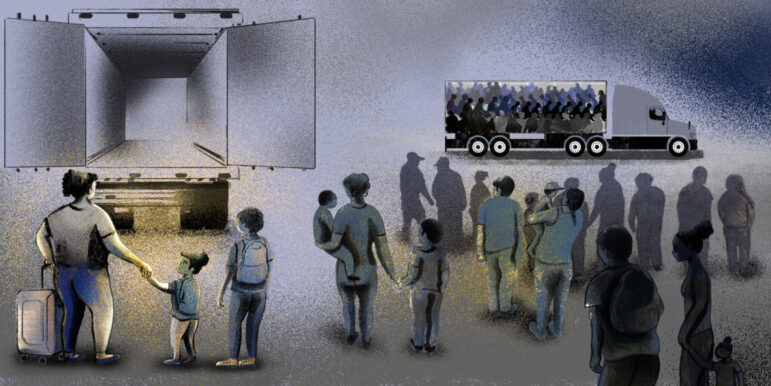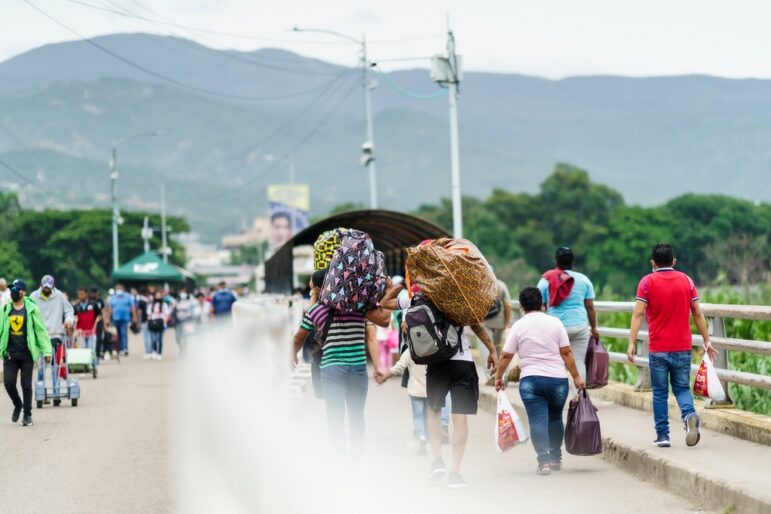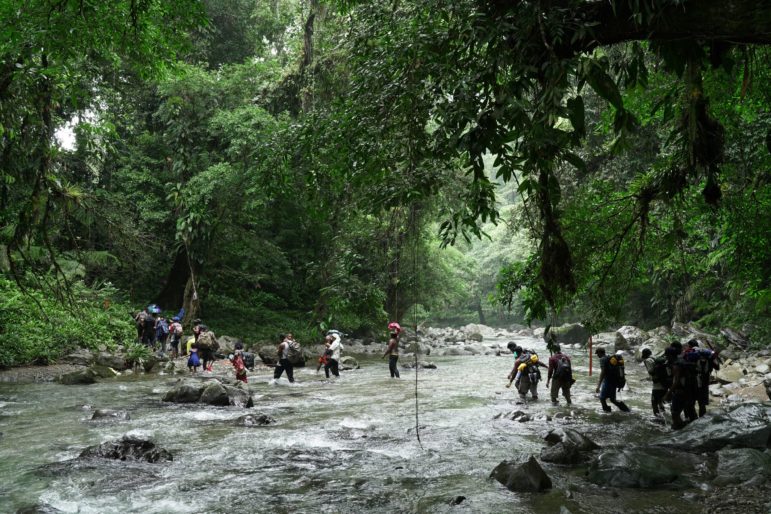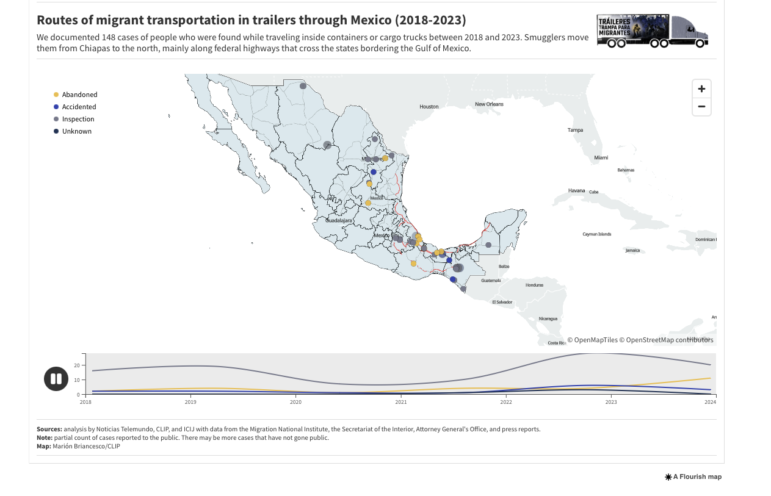

Illustration: Alejandra Saavedra López for CLIP, republished with permission
How They Did It: Investigating Migrant Abuses on Cargo Truck Smuggling Routes
Last year, a seven month-long collaborative investigation exposed systemic and lethal abuses involved with the growing use of cargo trucks to transport migrants and asylum seekers through Mexico. It found that at least 111 migrants were killed by suffocation or traffic accidents during a five-year period in which 19,000 people were transported this way, while also revealing the enabling government policies and the human trafficking strategies of the organized crime groups behind it.
Beyond the numbers, the nine-newsroom collaboration also revealed the shocking conditions adults and children are subjected to, and debunked common misconceptions that the majority of these migrants knowingly choose these journeys. This included survivor testimonies about multiple days of travel with 170 people in a single sealed container with two ablution buckets and no water; threats and assault by “coyote” smugglers; active deception about facilities and airplane transport; and the extortion of US-based relatives while migrants are detained en route. The team found zero records of official investigations into cargo truck human trafficking in two of the three Mexican states with the most related deaths — Chiapas and Nuevo León — and only three in the third, Veracruz.
In a behind-the-story session on “Tráileres, Trampa Para Migrantes” (Cargo Trucks: Trap for Migrants) at the 2025 Investigative Reporters and Editors (IRE) conference, members of four of the media partners explained the methodology behind this timely story, which won IRE’s Tom Renner Award and is also a finalist for GIJN’s 2025 Global Shining Light Awards.
Moderated by GIJN executive director Emilia Díaz-Struck — and delivered in Spanish and English — the panel included Àngela Cantador, an editor and data coordinator at the Latin American Center for Investigative Journalism (CLIP); Martha Olivia López, director of En Un 2×3 Tamaulipas, Brenda Medina, an investigative reporter with the International Consortium of Investigative Journalists (ICIJ); and Ronny Rojas, an investigative reporter for Noticias Telemundo.
Rojas said the project began when his team was reporting on a more narrowly focused story on 53 migrant suffocation deaths in a truck near the southern US city of San Antonio, and on the conditions in migrant cargo trucks on Texas roads.
“But when I talked to many of these people, they reported that their journeys inside cargo trucks in Mexico had been far worse than in Texas,” he recalled. “In Texas, these trips lasted for hours; in Mexico, it was two or three days — they told of terrible conditions, of being unable to get out and go to the bathroom or get water, many travelling with kids. I couldn’t believe it at first.”
Rojas was able to access these sources because Telemundo put out a call on stories and social media platforms, inviting readers to contact him if they had experienced traveling on a truck from the southern border, or known someone who has. Instead, he received numerous accounts of deeper abuses in Mexico.
View this post on Instagram
Why Care in Choosing Collaborators is Crucial
How, Rojas and his team wondered, could their US-based team take on the hazardous and multi-layered task of reporting on the much broader problem of people smuggling in trailers in countries south of the US border?
“I realized we had an untold story in front of us, but, sitting in the US, you don’t really have access to these sources, and you don’t know your way around these Mexican cities near the border,” he explained. “All you have are testimonials and assumptions about the causes of these problems, and how these criminal trafficking groups operate.”
He added: “I decided to approach CLIP, who have built this formidable network of journalists in the region.”
A classic case study on choosing reporting collaborators is the investigation into the murder of two Swedish United Nations human rights experts in the DRC in 2018, which was initially claimed to be a random killing by rebels. Here, initial reporting by Sweden’s TV news magazine, SVT Mission Investigate, not only suggested possible DRC government collusion and a UN cover-up of the murders, but also that their own team lacked specific skills needed to hold all the various culprits accountable.
So, they sought out as partners Foreign Policy Magazine, which offered rich UN contacts; Congolese freelance reporters, who understood the context of the government’s conflict with rebels; Süddeutsche Zeitung, with its leaks analysis and project coordination skills; and Radio France Internationale, whose language analysis skills would show that the final order to kill the pair was issued in Lingala — tellingly, a language spoken by government soldiers, but also the one language that local rebels refuse to speak on principle.
Similarly, Rojas said one reason Telemundo chose CLIP as their first partner was its staff’s understanding of the hazardous security landscape facing reporters in Mexico. This would become crucial as the team learned that drug cartels were increasingly involved with cargo truck people trafficking, as a source of income.
“We were not looking for people to risk their lives for us,” he emphasized. “We knew that CLIP knows how far to go, and how to be safe in that environment.”
In addition to CLIP and Telemundo, the migrant trucks collaboration eventually included a number of partners throughout Mexico, Central America, and the Caribbean: En un 2×3 Tamaulipas, Pie de Página, Chiapas Paralelo, Plaza Pública in Guatemala, Contracorriente in Honduras, ICIJ in the Dominican Republic, and Bellingcat.
For Rojas and CLIP’s Cantador, there were similar considerations in choosing additional media partners who could fill the reporting gaps that quickly emerged: unique knowledge of minority communities and migration drivers in Central American countries; open source research skills; deep law enforcement contacts; and all with the same goal of exposing the harms and practices of a growing phenomenon.
“It helps to know, early on, what kinds of partners you’ll need,” said Cantador. “The big challenge was to bring together big newsrooms and smaller newsrooms – all of us had different deadlines, different financing, different methods of working. That’s why the sharing of information was so open. The point is not to compete to see who gets the better story. Everyone had the same objective — it wasn’t as though a bigger newsroom with more money was hiring people to work for them as fixers.”
Another early discovery in the investigation was that official data did not exist on road accidents involving migrant smuggling and human trafficking in Mexico. So the team created its own database of more than 170 cases of migrant trucks that were involved in traffic accidents or abandonment between 2018 and 2023, drawing on press reports and federal documents.
The tips Rojas offers for building a database from scratch include:
- Remember to include variables that can answer deeper questions you may wish to ask at the end of the project. For instance, in addition to data on the destination of abandoned or crashed migrant trucks, and the numbers and nationalities of people inside, this project’s database included columns for incident dates and roadway locations. “This data eventually allowed us to see which roads smugglers were taking, to see which months of the year the business was more active, and how it increased in recent years as the Mexican authorities restricted safe passage of migrants through Mexican territory,” he explained.
- Be sure to standardize the values in your dataset — and beware of using publication style, such as Associated Press conventions, within your database out of habit. “If you decide that an important piece of data is the age of a migrant, you cannot mix numbers and words for those ages in a column – such as ‘Six eight, ten, 12.’”
- If there are no official databases, then figures manually extracted from agency press releases and press reports can suffice as sources. But be sure to explain those sources, and their limitations, to readers. “There are always ways to build a database from scratch, which is what we did with this story, even if it involves manual entry and some tedium,” he said.
Their methodology was also based on courageous shoe-leather reporting, as well as more than 70 records requests to Mexican authorities, careful data analysis, and testimonies from survivors, drivers, families, and officials.
“It was a horizontal collaboration,” Cantador noted. “No power structures in the project in a hierarchy, but it’s definitely important to have someone who coordinates for everyone else.”
For López at En Un 2×3 Tamaulipas, which is located in the capital of a key Mexican border state, the benefits of joining the project included impact and the shielding effect of a major partnership.
“Local journalism benefits from this type of collaboration because we are the ones who are hunting around for stories about these tragedies, but it is otherwise only when it is a huge tragedy, when so many die, that this gets international attention,” she said. “This project offered a lot of attention to detail and to the quality of the work. This type of collaboration also offers protection from retaliation for us local journalists who are working in the communities — who know where the cartels and organized gangs are operating, and the dangers.”
López added: “We grew up seeing migrants crossing, and we know the importance to go beyond the numbers and tell the stories of these people, and how this problem is recurring.”
Said ICIJ’s Medina: “Our hope is that newsrooms will continue to look to smaller outlets in Latin America, and help them put pressure on their governments to investigate these abuses and protect migrants.”
 Rowan Philp is GIJN’s global reporter and impact editor for GIJN. He was formerly chief reporter for South Africa’s Sunday Times. As a foreign correspondent, he has reported on news, politics, corruption, and conflict from more than two dozen countries around the world.
Rowan Philp is GIJN’s global reporter and impact editor for GIJN. He was formerly chief reporter for South Africa’s Sunday Times. As a foreign correspondent, he has reported on news, politics, corruption, and conflict from more than two dozen countries around the world.










